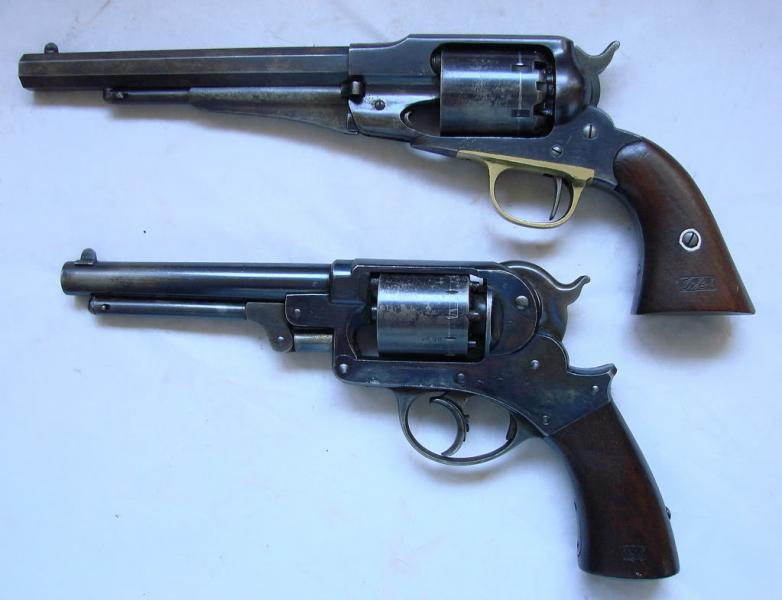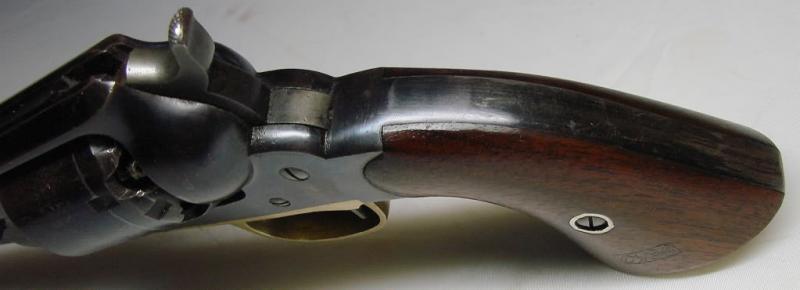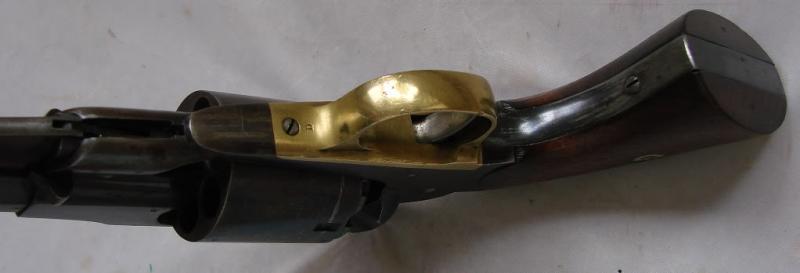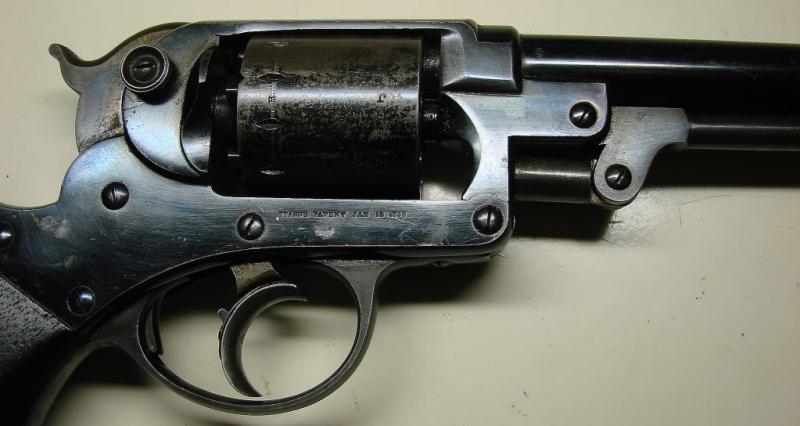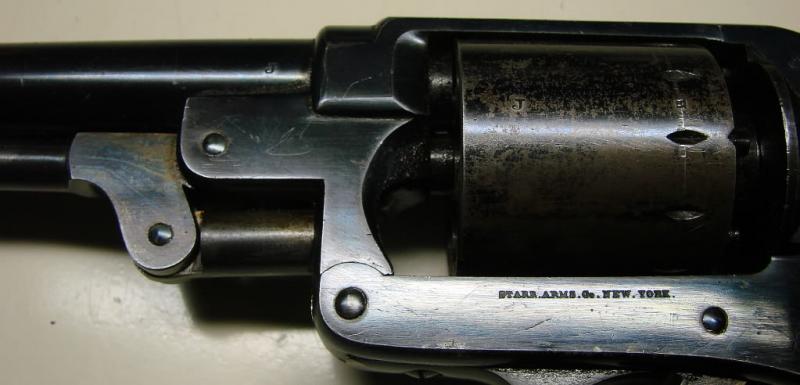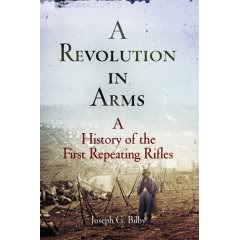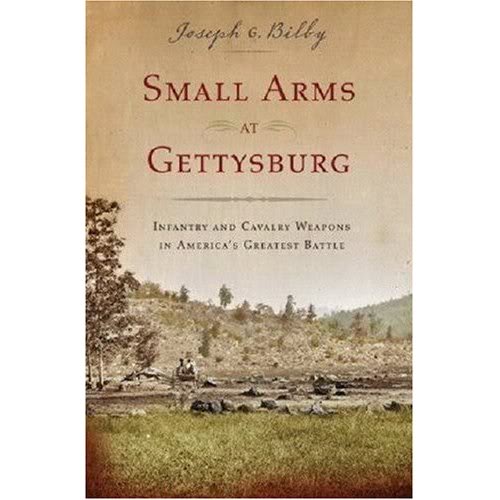-
Legacy Member

A U.S. Civil War Smith carbine-with a “possible” Fenian Raid (Canadian) involvement.
This is a Civil War period Smith carbine (Sn. 21198) with the name
“C.H. Duba” neatly stamped in four places on the stock.
(Click on the bar to enlarge the images.)
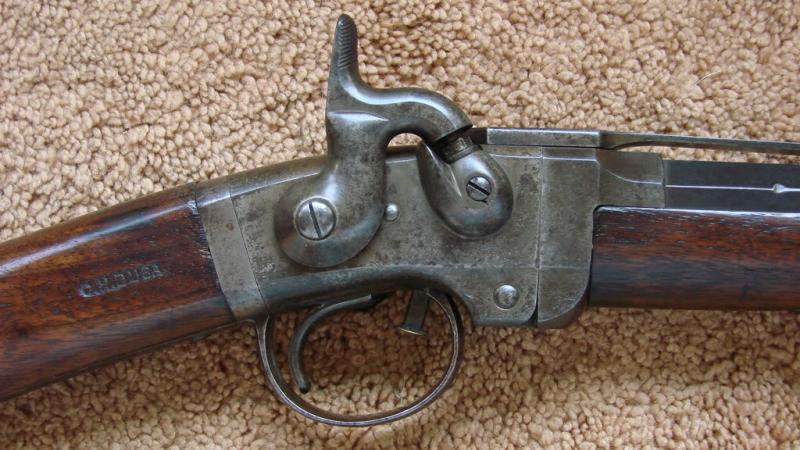

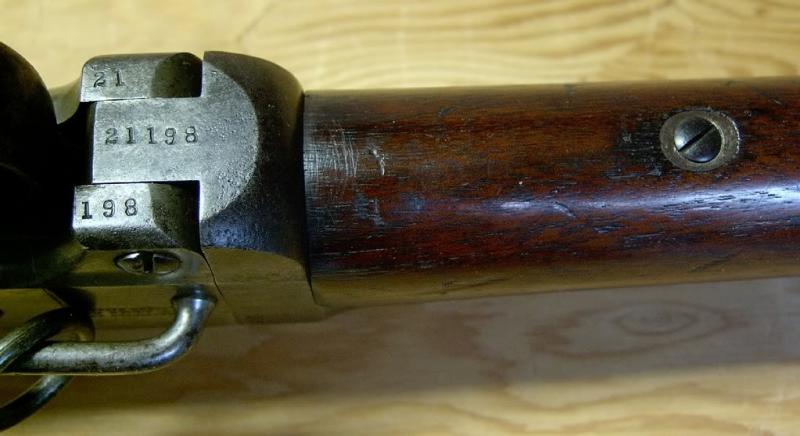
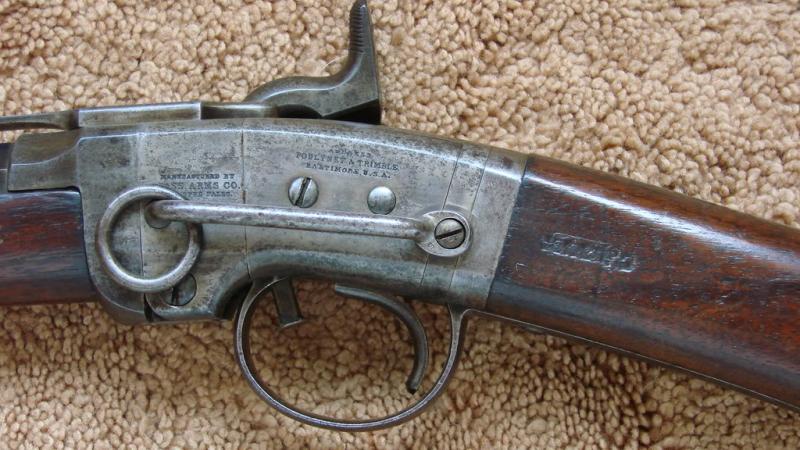

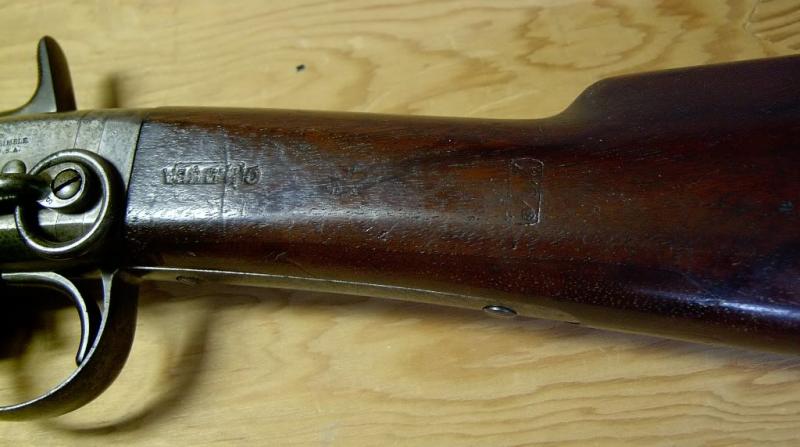
I had the research people at “The Horse Soldier” in Gettysburg do a search on
C.H. Duba…which is a bit of a particular name….it turned up a few Dubas but no C.H Duba.
It is on record that Smith Carbines were issued to the 12th Illinois cavalry,
and the results of the research shows a John Duba was mustered
into "E" Co. Il. 12th Cavalry 1/24/1862, and mustered out on 12/31/1865.
Duba, is an unusual name,... but C.H Duba is not John Duba.
__________________________________________________
As I had been communicating with Joe Bilby on some other stuff I asked him if he had seen these types of markings on other guns of that period.
Joe Bilby.
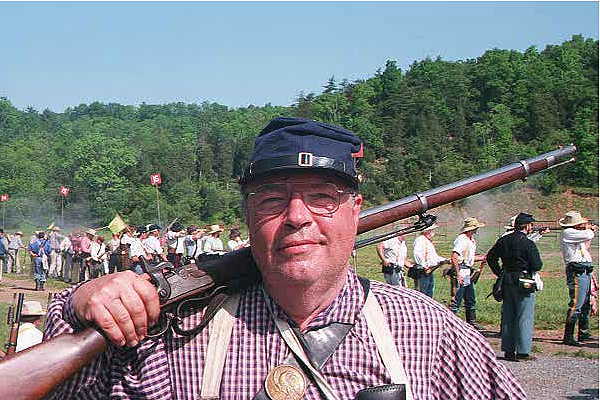
This is how the story played out which led into another story that involves my mother’s grandfather.
--------------------------------------------------------------------------
My question to Joe.
In your experience, have you seen these types of stamps before on other guns?
--------------------------------------------------------------------------
As a matter of fact, yes - Fenians had a tendency, if two of the conversion muskets are an indication, to mark guns like this.
One that a friend of mine owns has "Sgt. Noonan" stamped into the wood.
Joe
The 1866 Fenians were armed with rifle muskets and Smith carbines -- some of the Canadians
had Spencers, and the Canadian government bought more Spencers in the wake of the "invasion."
Unless they were personal weapons, the Fenians never used Spencers.
I mention this in passing in my new book on the Spencer and Henry.
The Fenians of 1870 were armed with the Needham conversion of the Model 1863 rifle musket.
The story is mentioned in Flayderman's "Guide" the guns were converted in
Trenton by Trenton Arms Company, and a Fenian leader was a silent partner in the company.
Joe
--------------------------------------------------------------------------
Irish Republican Army (Fenian Brotherhood), Vermont/Quebec Border, May 1870.
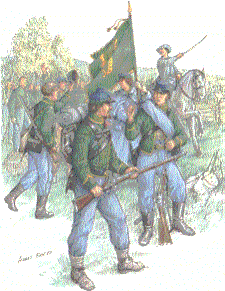
________________________________________________
Background:
In 1866 The Fenians started their raids into Canada , as indicated below
, as indicated below
thousands of Irish Brigade, Union and Confederate army veterans
were members of this movement.
Following the Fenian Raid of 1866 a well-to-do farmer Asa Westover, called
a meeting of his immediate neighbors and they agreed to form a Home Guard Unit
(The Red Sashes) .
Asa Westover and my mother’s great grandfather James G. Pell , both excellent marksmen,
were authorized to purchase arms for the Home Guard, and traveled
to Massachusetts to visit various arms makers.
They ended up purchasing 40 Ballard Rifles, which were used
against a force of 400 Fenians on May 24 1870 at the Battle of Eccles Hill
which is located in the Eastern Townships of Quebec just across
the Northern Vermont border.
--------------------------------------------------------------------------
Having written a book on the Irish Brigade, and being of Irish American heritage myself,
I am very familiar with the Fenians, as well as the perpetual
bungling that characterized their efforts. :-)
The 1866 invasion was actually tactically successful, if I recall,
but the victorious Fenians suffered the usual leadership lapse
after the Battle of Ridgeway. At that point most Fenian troops were CW vets.
By 1870, the vets had better things to do, and the Fenian force
that crossed into Canada with weird looking conversions
of CW muskets (designed by a Brit and made in a factory in
Trenton NJ by a firm that had a Fenian leader as secret partner)
were a lot of unemployed kids swept up off the streets of NYC --
of course the Canadians had no way of knowing that.
Am familiar with the Ballard story -- they chose wisely
-- very accurate long range guns, and the long range fire from the Ballards,
if I recall, made the Fenians decide they had business elsewhere. :-)
I like the personal relationship to the Ballard story.
Joe
__________________________________________________ _______
Some photos of the Home Guard following the Battle of Eccles Hill in 1870
against the Fenians and an example of the Ballard rifle that they used at that battle.
My mother's grandfather is dressed in white in both photos below.
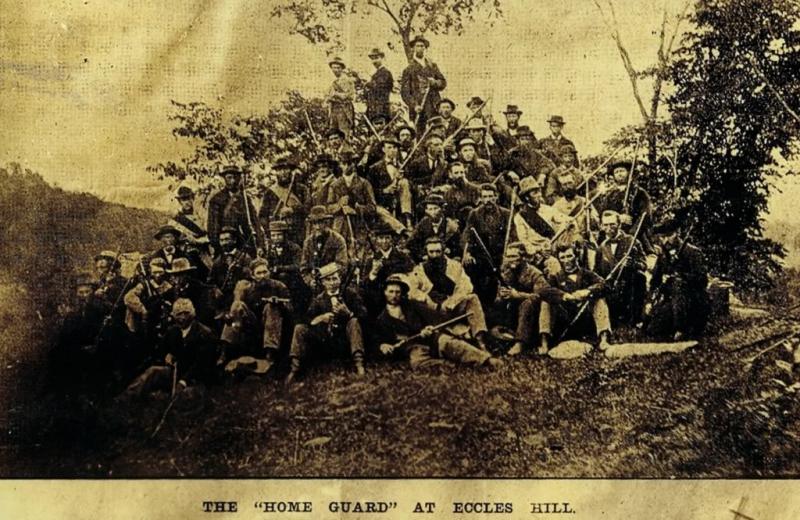

Captured Fenian cannon.
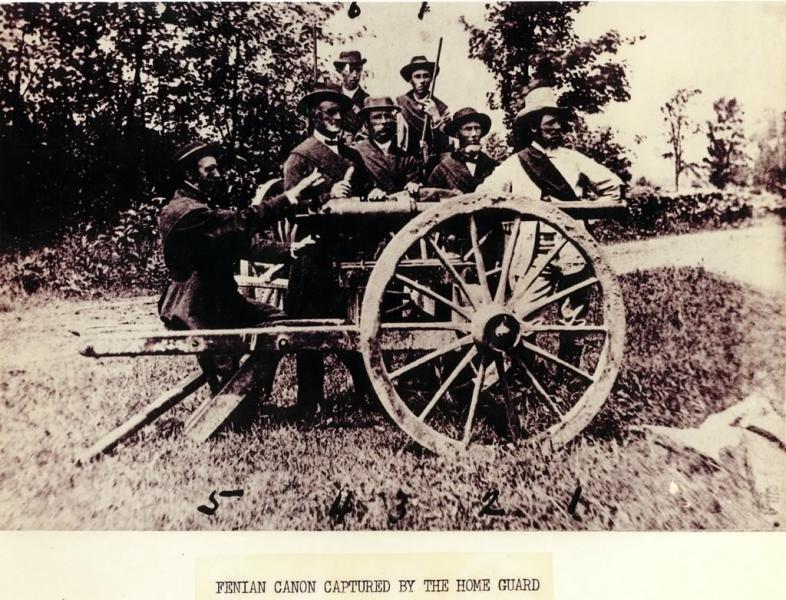
An example of the Ballard rifle that they used at that battle.

A little History-for they that may be interested.
The Fenian Raid and Battle of Ridgeway June 1-3, 1866.
The links.
Fenian Raid into Canada, 1866
The Fenian Raids
David
Information
 |
Warning: This is a relatively older thread
This discussion is older than 360 days. Some information contained in it may no longer be current. |
|
Last edited by drm2m; 04-09-2009 at 11:49 PM.
-
The Following 3 Members Say Thank You to drm2m For This Useful Post:
-
04-09-2009 11:01 PM
# ADS
Friends and Sponsors

-
Legacy Member

In 1866, the Fenians launched a series of raids on Canadian territory. One was at Pigeon Hill, on the Quebec-Vermont border. Led by a man named "General" Samuel Spear, several hundred Fenians marched six miles into Canada , where they planted a bright green flag. A small Canadian force saw them coming, but wisely retreated. The Fenians met no soldiers, so they busied themselves by stealing chickens, pigs, or liquor from farms in the area. A veritable armed mob, they plundered nearby St. Armand and Frelighsburg (Slab City), and, it was said, "insulted and abused" the local population. On hearing that Canadian reinforcements were approaching, the Fenians began a disorganized retreat to the U.S. The last 200 stragglers were charged by a volunteer cavalry troop who managed to capture sixteen prisoners. Once back on American soil, the Fenians had their guns confiscated by American soldiers.
, where they planted a bright green flag. A small Canadian force saw them coming, but wisely retreated. The Fenians met no soldiers, so they busied themselves by stealing chickens, pigs, or liquor from farms in the area. A veritable armed mob, they plundered nearby St. Armand and Frelighsburg (Slab City), and, it was said, "insulted and abused" the local population. On hearing that Canadian reinforcements were approaching, the Fenians began a disorganized retreat to the U.S. The last 200 stragglers were charged by a volunteer cavalry troop who managed to capture sixteen prisoners. Once back on American soil, the Fenians had their guns confiscated by American soldiers.
The Battle of Eccles Hill- May 25th 1870.
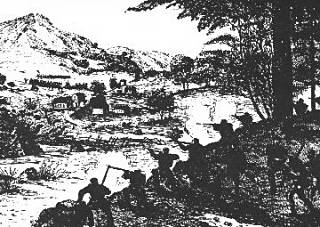
Two members of the Home Guard, 1870. (Source: Missisquoi Museum)
They are seen with their Ballard rifles.
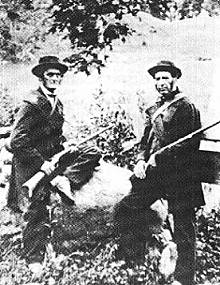
Another raid occurred in 1870 at Eccles Hill (not far from Pigeon Hill), when 400 Fenians under the command of "General" John O'Neill, President of the Fenian Brotherhood, were repulsed by a much smaller group of Canadian home-guard and militiamen who were waiting there to meet them. Two Fenians were killed and nine were injured. No Canadians were hurt or killed. O'Neill's words to his troops were these: "Men of Ireland, I am ashamed of you."
A little more background regarding these events----sorry if some it repeats what has already been mentioned above.
Steps were quickly taken to acquire newer breechloading weapons. The Canadian government purchased 3,000 Peabody rifles, with bayonets, from the Providence Tool Company of Providence, R.I. Starr carbines and Spencer repeating rifles were also acquired in the United States .
.
The farmers of the St. Armand area, concerned about their lack of defense during the Fenian raid of 1866, sent two representatives south to Massachusetts, where they bought 40 Ballard sporting rifles. It is curious to note that the U.S. government took no steps to impede those arm sales to a foreign government with whom relations were strained.
Perhaps believing that a military victory would unite the organization, or perhaps choosing to act before his power base totally collapsed, O’Neill prepared for another invasion of Canada in the spring of 1870. He established a base of operations at Franklin, Vt., where he positioned his war stocks of 15,000 weapons and 3 million rounds of small-arms ammunition. O’Neill had also been able to acquire at least one field artillery piece.
The time came for his volunteers to assemble, but no more than 400 men arrived to arm themselves for the next great Fenian expedition. A far smaller group was assembling near Malone, N.Y., to conduct a simultaneous attack. When General O’Neill and his small army set off for the Canadian border on the morning of May 25, 1870, they must have been greatly disappointed that so few of their comrades had turned out for the invasion.
Lieutenant Colonel William Osborne Smith, a Canadian career army officer, was the commander of the military district that lay in the path of the Fenian advance. Osborne Smith had received intelligence reports of Fenian activity as early as May 22 and had issued orders for the militia to mobilize. While units from the Montreal area marched south, local militia organizations occupied defensive positions on the border.
The farmers who had suffered property losses during the Fenian raids of 1866 had banded together to form the Missiquoi Home Guard. With Ballard sporting rifles firmly in hand, 37 members of the guard occupied the strategic heights of Eccles Hill, which gave them a commanding view of the border to the south. Lieutenant Colonel Brown Chamberlin soon reinforced the home guards with members of the 60th Missiquoi Battalion.
Osborne Smith, who was hurrying to the border with the 3rd Victoria Rifles and the Montreal Troop of Cavalry, raced ahead to Eccles Hill. He conferred with Chamberlin about the defense plan and then galloped away to bring up additional units. After traveling a few miles, Osborne Smith was halted by a messenger from the south who informed him that the Fenian attack had commenced. Turning around, Osborne Smith drove his lathered mount back to Eccles Hill, where he personally assumed command.
The Fenian advance guard crossed the border around noon. As the Irishmen marched in close ranks, they came under a withering hail of fire from the concealed positions of the home guards. Surprised by the Canadian troops’ determined defense, the Fenians scattered, either taking cover or retreating across the border.
Just after 1 p.m., U.S. marshals located O’Neill near the Vermont border and arrested him. O’Neill, who probably realized that his offensive was doomed to failure, made no effort to evade the lawmen.
One of the Fenian leaders who fell during the attack was Captain E. Croman, a Civil War veteran who had somehow managed to receive a first-class certificate from the Montreal Military School for militia officers. He died of his wounds a few days after the battle.
For several hours the militia and the Fenians exchanged fire. At about 2 p.m., the Montreal Cavalry and the Victoria Rifles arrived to bolster the Canadian defenses. Likewise, the Fenian force was strengthened by 100 men of the 4th New York Fenian Regiment.
At 5:45 p.m., Osborne Smith was informed that the Fenians were bringing up field artillery to bombard the Canadian position. He determined that it was time to seize the initiative. Positioning the Victoria Rifles on high ground to cover the attack, he ordered the home guards and the 60th Missiquoi Battalion to advance. The Canadian charge was too much for the Irish Americans, who sprinted across the border, leaving much of their equipment behind. Two Fenians were killed and several more were wounded. The victorious Canadians were completely unscathed.
A halfhearted Fenian attack near Holbrook Corners, Quebec, was easily repulsed two days later by a massed force of 1,000 Canadian militia and British Regulars.
Regulars.
The Fenian drama was over.
Last edited by drm2m; 04-10-2009 at 01:50 PM.
-
The Following 3 Members Say Thank You to drm2m For This Useful Post:
-
FREE MEMBER
NO Posting or PM's Allowed

`You shooting it?
I shot my original Smith for years w/ 7th Regt VA Inf - NSSA, along w/ my `61Colt Special Model for musket. That pic of Ft. Shenandoah brought a lotta memories....
The originals never seemed to wear -- and had lock mechanisms that were smooth and crisp.
-
Legacy Member

-
-
Legacy Member

-
Thank You to drm2m For This Useful Post:
-
FREE MEMBER
NO Posting or PM's Allowed

-
FREE MEMBER
NO Posting or PM's Allowed


Originally Posted by
drm2m

The farmers of the St. Armand area, concerned about their lack of defense during the Fenian raid of 1866, sent two representatives south to Massachusetts, where they bought 40 Ballard sporting rifles. It is curious to note that the U.S. government took no steps to impede those arm sales to a foreign government with whom relations were strained.
My guess is that the US government of 1870 (Ulysses S. Grant, President, if I remember correctly) had a better grasp of reality than more recent administrations.
Since Canada was closely associated with Britain
was closely associated with Britain (I believe that they got Dominion status in 1867) the Canadians could simply get any number of functional rifles from the U.K. The net strategic loss to the US from selling rifles to Canada was pretty much zero, and at least our guys & workers got the business.
(I believe that they got Dominion status in 1867) the Canadians could simply get any number of functional rifles from the U.K. The net strategic loss to the US from selling rifles to Canada was pretty much zero, and at least our guys & workers got the business.
In other words, don't boycott if they have other sources for what they want -- it only hurts you economically and makes you look foolish.
-
Legacy Member

Excellent thread guys. I've visited Eccles Hill, Quebec three or four times. The more I read about the defence, the more intrigued I am at the self reliance of the local guard. They mounted vital point protection against a vocal and blustering invading threat. They kept on guard until the big city militia units got their acts together and rode to the relief. Unrecognized today, but heroes who protected themselves and their villages.
Eccles Hill is different today than 1866. The hill is a granite outcropping that dominates a small creek which forms the border. Although the 45th Parallel is the border, right there it is at a bridge. The rock is exposed on the cresent shaped summit, with gravelly rock and soil slopes. It is farmed on two sides today, but in the 1860's the trees were clearcut for small farms, firewood, lumber and as nuisances. The sheltered area behind the crest would be the sort of place a modern trained infantry leader would use for his CP, mortar pits, HLZ and sleeping areas. I can only imagine the Canadians put their horses, cooking fires and tents in there. The cannon in the pictures is there, cemented into a crude base. The local historical society put up a brass plaque to acknowledge the significance of the site. One commentator didn't think the wedge breech was correct for that time frame.
The 1866 Raids lit a fire under the provinces to stop chattering, and seriously negotiate with each other and London to form what is now Canada in July 1867. Britain
in July 1867. Britain was not the least bit happy to be neighbours with a restless US of A, full of unemployed Union veterans, weapons and war-experienced leaders, London reinforced its garrisons, moved some ships closer and started to resupply the Militia. But the local forces were not a fully capable armed force. More of a jolly good social scene for decent gentlemen, looking to improve their prospects and standing in constrained communities. In 1870, the tables were much more favourable to the defenders. Many contemporary regiments claim their lineages from the 1860s, and some have battle honours chasing Fenians back across the border.
was not the least bit happy to be neighbours with a restless US of A, full of unemployed Union veterans, weapons and war-experienced leaders, London reinforced its garrisons, moved some ships closer and started to resupply the Militia. But the local forces were not a fully capable armed force. More of a jolly good social scene for decent gentlemen, looking to improve their prospects and standing in constrained communities. In 1870, the tables were much more favourable to the defenders. Many contemporary regiments claim their lineages from the 1860s, and some have battle honours chasing Fenians back across the border.
-
Thank You to Maple_Leaf_Eh For This Useful Post:
-
Advisory Panel


For information on Canadian Fenian raid arms see" Defending the Dominion" by Edgecombe. The british govt bought Spencer rifles and carbines for use in Canada as well as Starr M1865 carbines. Most of these arms were turned over to Canada. These arms can be identified by a W^D stamp on the butt.
as well as Starr M1865 carbines. Most of these arms were turned over to Canada. These arms can be identified by a W^D stamp on the butt.
-
, as indicated below



























 PM
PM








